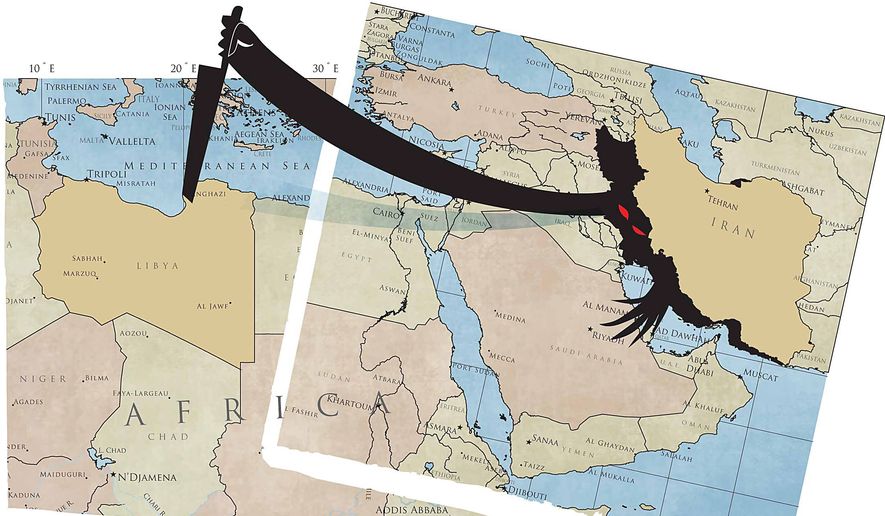OPINION:
In the aftermath of the 2012 Benghazi attack that killed four Americans, Defense Intelligence Agency Director Lt. Gen. Michael T. Flynn tasked the intelligence community for information on Iran’s involvement in the attack.
Until now, government officials have refused to acknowledge any Iranian involvement in Benghazi. But the Flynn memo indicates that at least some in the U.S. intelligence community suspected Tehran from the very beginning.
A top secret Sept. 21 memo responding to the director’s inquiry and disclosed as the result of a Freedom of Information Act request from the conservative watchdog group Judicial Watch includes fragmentary information on al Qaeda affiliates. But its conclusions regarding Iran’s notorious Quds Force, a deadly hybrid of intelligence and special operations, have been totally redacted.
Now retired, Gen. Flynn told The Washington Times that, for classification reasons, he could not discuss the memo’s redacted contents or talk about his four hours of secret testimony for the House Special Benghazi committee. He did note, however, that a recently declassified trove of letters from al Qaeda leader Osama bin Laden reveal that Shiite Iran was willing to help Sunni militants if the common foe was the United States.
The U.S. military has crossed swords with Iran’s Quds Force in Iraq, Syria, Libya, and Yemen where the Quds Force used a similar tactic to what sources believe they use in Benghazi: infiltrating a paramilitary operations team into a hostile environment under cover of humanitarian aide workers for the Red Crescent Society, the Muslim equivalent of the Red Cross.
A Red Crescent team from Iran arrived in Benghazi, Libya on July 30, 2012, ostensibly to provide humanitarian aide to the post-Gadhafi revolutionary regime. The secret CIA Annex operating in Benghazi had been tipped off and dispatched local “watchers” to track their movements, according to Dylan Davies, a British security contractor in charge of the local guards protecting the Benghazi facility.
“Everyone knew the Iranians were in Benghazi,” former CIA security officer Kris “Tanto” Paranto said in an interview. “Especially once the Red Cross [Red Crescent] team from Iran was ’kidnapped’ by Ansar al-Shariah, we knew about them and were tracking them.”
The “kidnapping” was reported in the Libyan press as the result of a feud between Sunni militiamen and an Iranian Shiite medical team, but in fact was a carefully staged deception operation to lead the CIA off the track.
“The kidnapping of the Red Crescent team in Benghazi was a false flag operation,” a U.S. Special Forces flag officer who was then providing intelligence support for overseas operations said.
“They were actually Quds Force operatives. The kidnapping was arranged to make it look like they were being taken hostages, when actually they were being taken off the street so they could covertly direct the attack on the U.S. compound. “We know from liaison relationships that Iranians did the training. They organized the militia and taught them how to zero in the mortars. They set up sophisticated surveillance of the consulate — and they did it all while they were ’hostages,’” he said.
This information was reported “up the food chain” by the CIA Chief of Base in Benghazi, a former U.S. Army officer. “He was later told, don’t talk about the Iranian connection, with threat of sanction,” the flag officer said in an exclusive interview.
Two defectors from Iranian intelligence organizations later revealed the role played by the Red Crescent operational team in Benghazi. They claimed that a courier carrying between $8 million to $10 million in 500-euro notes arrived three weeks before the attack, and that a senior Quds Force operative, Ibrahim Mohammad Joudaki, distributed the money to Ansar al-Shariah leaders controlled by Iran.
Multiple intelligence and operations officers at U.S.-Africa Command (AFRICOM) in Stuttgart have acknowledged an “ongoing awareness” of the Iranian Quds Force presence in Benghazi and elsewhere in Eastern Libya. Among them is Lt. Col. Andrew Wood, the chief of the 18-man Site Security Team assigned to guard Ambassador J. Christopher Stevens at the U.S. embassy in Tripoli. After seeing a PowerPoint flow chart from Africom headquarters at a June 2012 security briefing at the U.S. embassy in Tripoli that showed Iranian weapons and money flowing into Libya, Col. Wood sent an email back to his commander, Rear Adm. Brian Losey, asking for additional support. “Sir, Ansar al-Shariah has had their funding approved,” he wrote.
The Treasury Department has been detailing Iran’s ongoing operational relationship with al Qaeda since 2005 in a series of terrorist designations. And just last week, a federal district court in New York again found that Iran provided direct material assistance to al Qaeda in the 9/11 attacks in 2001 and awarded the families of 9/11 victims $10 billion in damages against Iran.
Until now, the U.S. intelligence community has shied away from pointing fingers at Iran on Benghazi, at least in public. Bringing the truth to light about Iran’s involvement would be the single greatest accomplishment Rep. Trey Gowdy and the Benghazi Select Committee could achieve.
• Kenneth R. Timmerman is the author of “Dark Forces: The Truth About What Happened in Benghazi” (Broadside Books, 2014) and president of the Foundation for Democracy in Iran.




Please read our comment policy before commenting.